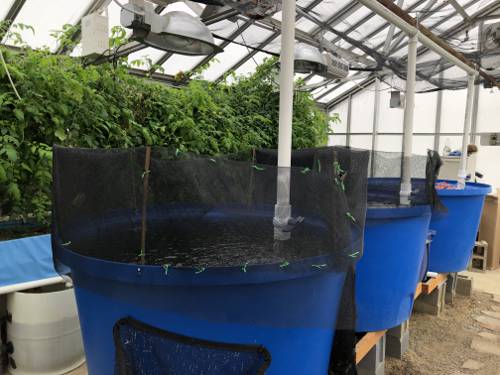
FAQ About Aquaponics for Indoor Plants

What is aquaponics and how does it work with indoor plants?
Aquaponics is a sustainable farming method that combines aquaculture (raising fish) and hydroponics (growing plants in water) in a symbiotic environment. In this closed-loop system, fish waste provides an organic nutrient source for the plants, and the plants, in turn, help purify the water for the fish. For indoor plants, aquaponics can be scaled down to fit conveniently in various residential spaces, allowing for fresh produce and ornamental plants to thrive alongside fish.

What are the benefits of using aquaponics for indoor plants?
Aquaponics offers numerous benefits for indoor plants, including space efficiency, reduced water usage, and the ability to grow plants without soil. It creates a balanced ecosystem where plants are naturally nourished by the fish waste, reducing the need for chemical fertilizers. Additionally, it can be a visually pleasing feature in a home, combining water, plant life, and fish to create a relaxing environment.

Which types of fish are best suited for aquaponics systems indoors?
Tilapia, goldfish, and small koi are popular choices for indoor aquaponics systems due to their hardiness and ease of care. Betta fish and certain species of catfish can also thrive in these environments. It’s important to select fish that are suitable for indoor tanks regarding space, temperature, and dietary needs.

Can all plants be grown using aquaponics indoors?
While many plants can thrive in an aquaponic system, it is particularly well-suited for leafy greens like lettuce, spinach, and herbs such as basil and mint. Some fruiting plants like tomatoes and peppers can also be grown with careful management. Ornamental plants like certain ferns and houseplants that can handle high humidity and moisture levels are also compatible with aquaponics systems.

How do you set up an indoor aquaponics system?
Setting up an indoor aquaponics system involves choosing the right size tank and grow bed, selecting compatible fish and plants, and ensuring a reliable water pump and filtration system are installed. It's crucial to establish a bacterial environment to convert fish waste into nutrients for the plants. Regular monitoring of water quality, pH levels, and temperature is also necessary for a thriving system.

What maintenance does an indoor aquaponics system require?
Regular maintenance of an indoor aquaponics system includes monitoring water quality, such as pH, ammonia, nitrate, and nitrite levels, and ensuring they stay within optimal ranges. Fish need to be fed daily, and the system may require periodic cleaning to prevent algae growth. Checking for clogging in pipes and maintaining the pump and aeration devices is also essential to keep the system running smoothly.

How does aquaponics compare to traditional soil gardening indoors?
Aquaponics uses 90% less water compared to traditional soil gardening and eliminates the need for chemical fertilizers as the fish serve as a natural fertilizer source. Additionally, aquaponics systems for indoor use usually take up less space and can sometimes lead to faster plant growth due to the nutrient-rich growing environment. However, they require an initial setup and learning investment to manage the ecosystem effectively.

What challenges are associated with indoor aquaponics?
Some challenges of indoor aquaponics include managing water quality and temperature, ensuring adequate light for plant growth, and preventing disease outbreaks among fish. Additionally, there can be a learning curve related to balancing fish and plant health, requiring regular monitoring and sometimes adjustments to the ecosystem conditions.

Can aquaponics be used to grow flowers indoors?
Yes, many types of flowers can be grown indoors using aquaponics. Examples include water-loving flowers like lotus and water lilies, and certain terrestrial flowering plants that can adapt to the high moisture levels involved in aquaponic systems. Maintaining the proper ph balance and ensuring sufficient light are key to successful flower cultivation in these systems.

What kind of lighting is needed for indoor aquaponics?
Indoor aquaponics systems require proper lighting to mimic natural sunlight, which can be achieved through LED grow lights specifically designed for plant growth. These lights should be chosen based on the type of plants being grown; for example, plants that produce fruit may require higher-intensity lighting compared to leafy greens. Regular monitoring and adjusting of light cycles can also help optimize growth conditions.

Is aquaponics environmentally friendly?
Aquaponics is considered environmentally friendly due to its water efficiency, reduced reliance on chemical fertilizers, and ability to recycle waste into nutrients. It creates a self-sustaining ecosystem that minimizes waste and pollution, aligning with sustainable agricultural practices. Moreover, it allows for local food production, reducing the carbon footprint associated with transportation.

How can aquaponics benefit urban dwellers?
For urban dwellers, aquaponics provides a convenient way to engage in gardening and produce fresh food within limited space. It supports local food growing, decreases dependency on supermarkets, and provides a unique hobby that can enhance quality of life through the health benefits of fresh produce and the soothing qualities of having an ecosystem indoors.

Can children benefit from learning about aquaponics?
Yes, children can greatly benefit from learning about aquaponics. It serves as an engaging educational tool that teaches them about biology, ecology, and sustainability. Seeing the growth of plants and care for fish in an aquaponics setup can spark interest in science and the environment, promoting eco-friendly practices from a young age.

Is it difficult to balance fish and plant needs in an aquaponics system?
Balancing fish and plant needs in an aquaponics system can initially be challenging as it requires understanding the interdependent ecosystem. Both the plant and fish species must be compatible with the environmental conditions provided. However, once the system is properly established and regularly maintained, it can become self-regulating with minimal adjustments needed.

What are the startup costs for an indoor aquaponics system?
The startup costs for an indoor aquaponics system can vary widely depending on the scale and materials used. Basic setups may range from a few hundred dollars, using small tanks and homemade components, to more sophisticated systems costing several thousand dollars with automated features and higher-end equipment. Regardless of the budget, it's possible to start small and expand as you gain experience.

How do you control pests in an indoor aquaponics system?
Pest control in an indoor aquaponics system can be managed by using organic methods such as introducing beneficial insects, using insecticidal soaps, or neem oil. Since the use of chemical pesticides is not recommended due to potential harm to the fish, maintaining a balanced ecosystem and ensuring the plants are healthy are key strategies in minimizing pest problems.

What is the role of bacteria in an aquaponics system?
Bacteria play a crucial role in aquaponics systems by converting fish waste into nutrients that plants can absorb. This process, known as biofiltration, involves nitrifying bacteria that convert ammonia from fish waste into nitrites and then into nitrates, which are beneficial for plant growth. The presence of these bacteria is essential for maintaining a healthy and productive aquaponic system.

Can aquaponics systems be automated for indoor use?
Yes, aquaponics systems can be automated to some extent, especially in indoor environments. Automation technologies can regulate water levels, monitor pH and nutrient concentrations, and control lighting and aeration. Using sensors and timers, it is possible to create a more management-free ecosystem, allowing for regular monitoring and automatic adjustments as needed to optimize conditions.

How does seasonal change affect indoor aquaponics?
Indoor aquaponics systems are generally less affected by seasonal changes compared to outdoor systems. However, indoor temperature and light availability may change with the seasons, potentially impacting plant growth and fish activity. It’s important to monitor environmental conditions and make necessary adjustments such as modifying light cycles and ensuring consistent temperatures to maintain system productivity year-round.

Is aquaponics suitable for all climates when installed indoors?
Yes, aquaponics is suitable for all climates when installed indoors because it provides a controlled environment where temperature, light, and humidity can be regulated independently of outdoor weather conditions. Whether dealing with extreme cold or heat, an indoor aquaponics system can be adjusted to provide optimal living conditions for both fish and plant life.
